Cinnamon Raisin Sourdough bread is filled with plump raisins, swirled cinnamon sugar in an artisan sourdough loaf! It’s got a crusty exterior, incredible airy crumb and is delicious toasted for breakfast.
This will be your go-to guide for Cinnamon raisin sourdough, made in one bowl, baked in a Dutch oven – it’s one of our favorites! Be sure and watch the step-by-step video below.

Easy to follow recipe uses a cinnamon sugar spread similar to making cinnamon rolls for perfect cinnamon sugar swirled throughout the bread. Because this dough has good hydration, there is no need to soak the raisins. Sourdough cinnamon raisin bread is soft, moist and a has a flavorful cinnamon raisin swirl.
My favorite way to make this bread is to double the recipe and divide it into three loaves – into 8-inch bannetons. It’s the perfect size loaf. Because the dough cold proofs, you can bake them at your convenience.
I’ve spent three-months researching, testing different recipes & methods and baked countless loaves with mixed results, until I got it perfect. My journey began with attempting to create a beginners sourdough recipe.

Why this recipe works
- Ease – No kneading involved. A bread machine or a stand mixer is not required.
- Simple ingredients – Basic ingredients including water, bread flour and salt, readily available at most grocery stores.
- Lower hydration – Which makes this sourdough bread recipe obtainable for those who are just starting out. This is a 75% hydration sourdough.
- Clear instructions – Easy to follow, detailed instructions and step-by-step guidance for even those who have never baked bread will have success.
- Incredible flavor – Has that signature tangy flavor, plump raisins and cinnamon sugar swirled throughout.
What you’ll need
- Active sourdough starter – Made with water, flour and the wild-yeast in the air in our surroundings. Used in place of store-bought active dry yeast.
- Unbleached bread flour – Use a high-quality brand, 12.5% protein bread flour or all-purpose flour helps build proper gluten structure. We suggest King Arthur Flour, Bob’s Red Mill or something locally produced work best.
- Salt – It adds flavor and natural preservative. In addition, tightens the gluten structure in flour, giving you more elasticity in the dough which will helps trap the gases (CO2) formed in fermentation and hold its shape better.
- Water – We use tap water that is lukewarm to help keep the dough warm. This helps with the fermentation process.
- Cinnamon sugar mixture – Create a cinnamon sugar paste that has softened butter, brown sugar, flour and cinnamon. Added after bulk fermentation and right before shaping. (Flour acts as a binder with this mixture and keeps the cinnamon sugar from dissipating.)
Sample baking schedule
- 5 pm – Feed your starter.
- 9 am – Mixing the dough and allow to rest 30 minutes.
- 9:30 am – Add salt and reserved 25 grams of water. Complete first stretch and fold. Let rest 30 minutes.
- 10 am- 11:30 am – Add raisins, complete stretch and folds.
- 11:30 am- 1:30 pm -The dough will rise about 30-50%.
- 1:30 pm – Add cinnamon sugar mixture and shape into a loaf. Place into rice floured bannetons and cold proof.
- 8 am Preheat oven with the Dutch oven.
- 9 am – Score one deep cut at 45 degree angle. Bake in a preheated Dutch oven.
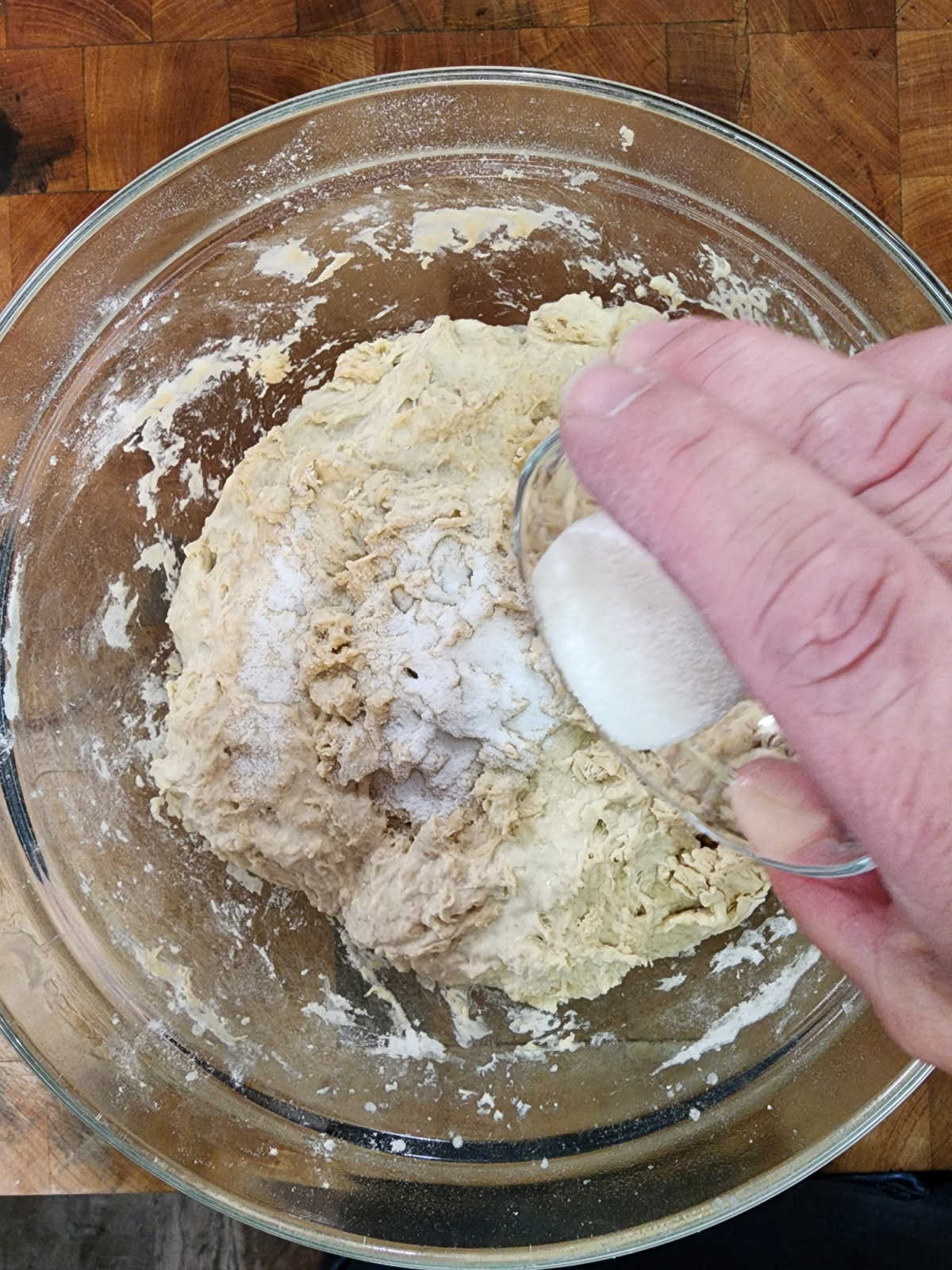

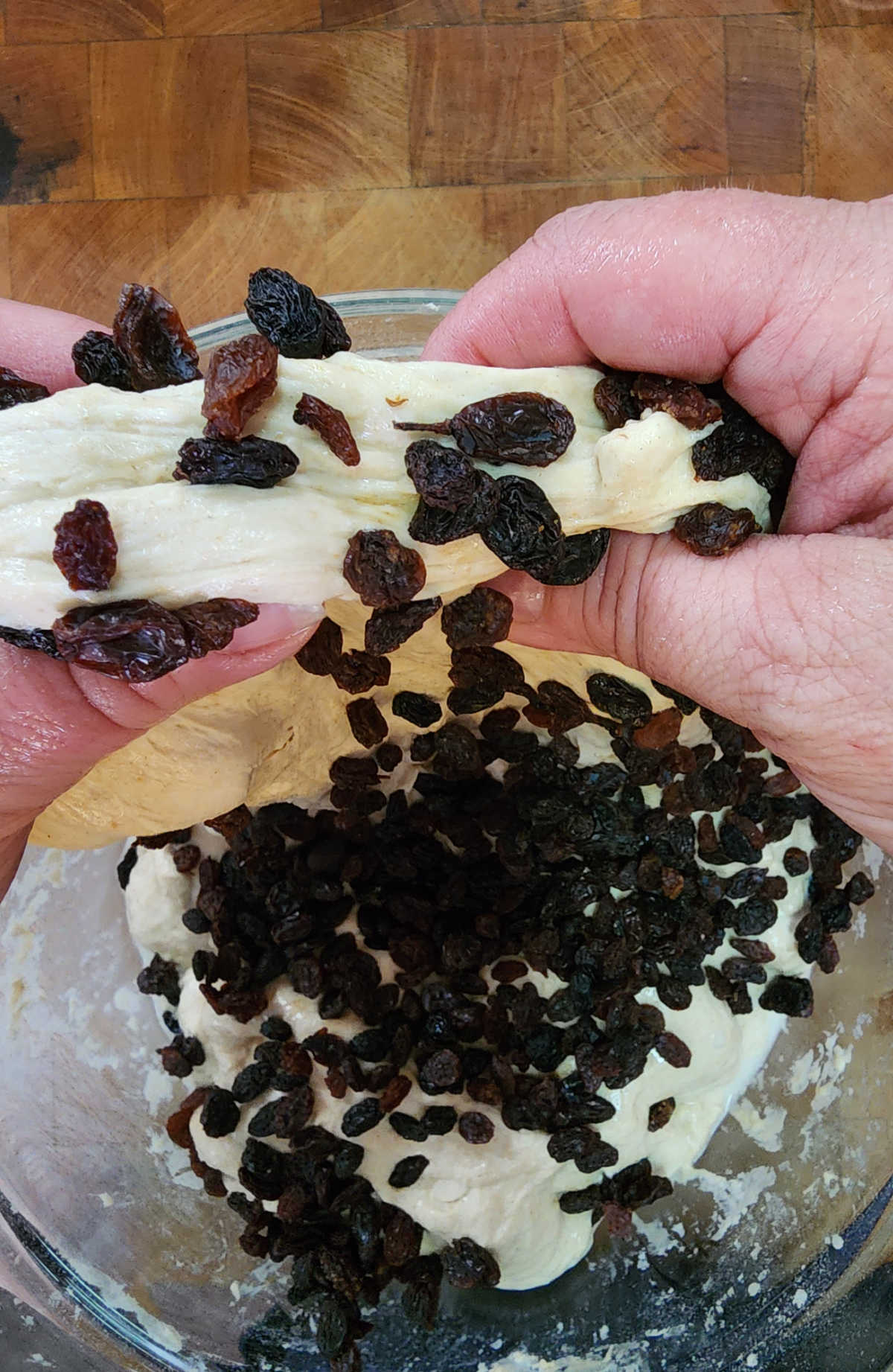
Wetting your hands slightly before completing stretch and folds on sourdough greatly helps them not stick to the dough.

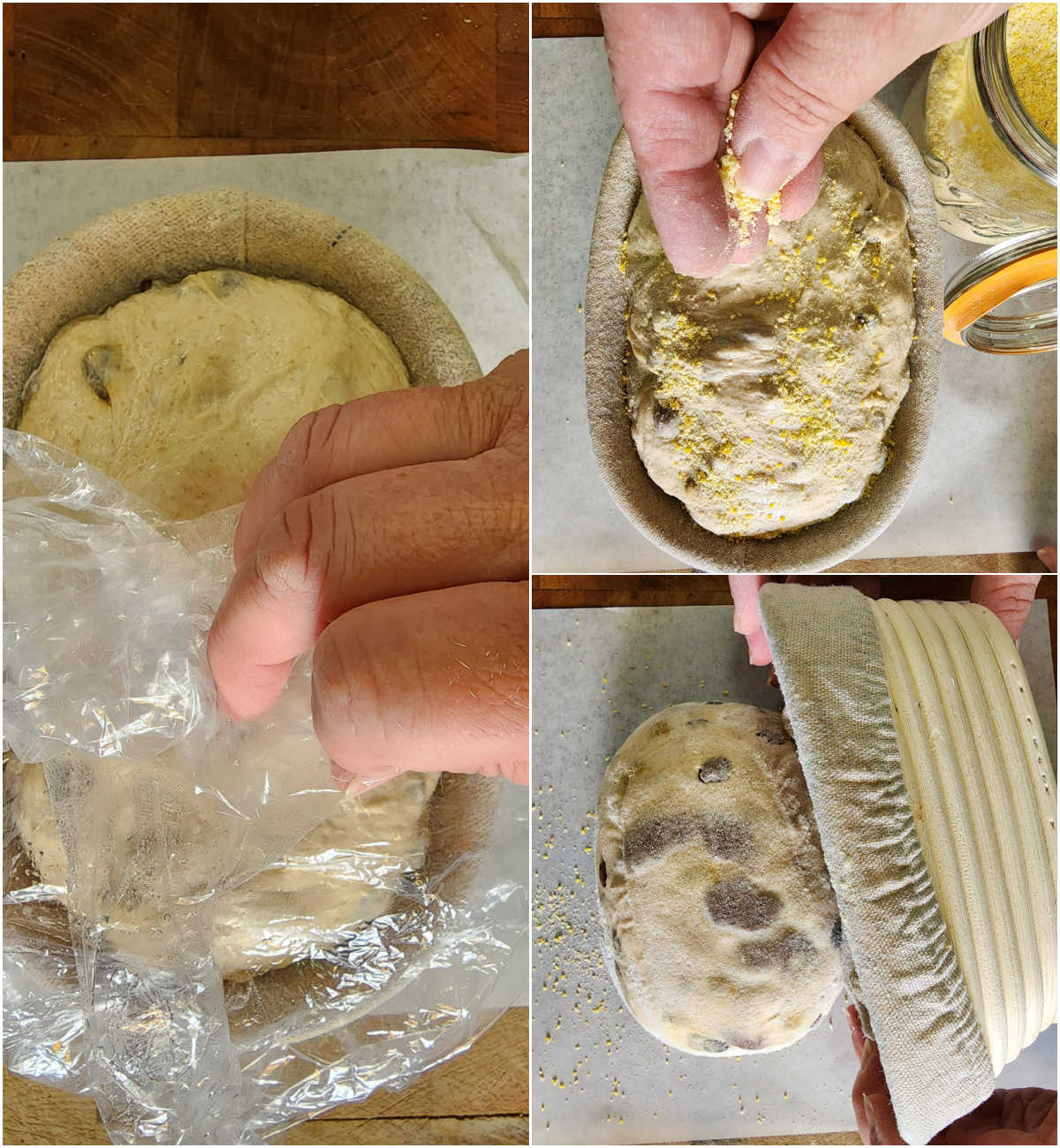
How to make Cinnamon Raisin Sourdough Bread
- Feed starter – The night before, feed your starter and leave in a warm area to double in size. Once peaked, refrigerate overnight.
- Fermentolyse – Mixing the water, active starter, and flour, then allowed to rest for 30 minutes.
- Mixing – Sprinkle the salt over the dough, add the reserved 25 grams of water and squish in with your fingers to incorporate. Complete first stretch and fold. Let rest 30 minutes.
- Bulk Fermentation – Complete stretches and folds (S&Fs) with 30-minute intervals in between. This helps build gluten and ultimately strengthen the dough. Add raisins during second set of stretch and folds.
- Warm and complete bulk fermentation – The dough will rise about 30-50%. You’ll see fermentation bubbles in the dough.
- Shape dough – Add cinnamon sugar mixture and shape into a loaf. Place into rice floured bannetons.
- Cold proof dough – Cover proofing baskets with reusable shower caps, refrigerate overnight and up to 36-hours. A long, cold proof will make for a much lighter, open, airy crumb.
- Preheat the oven – Preheat the oven and Dutch oven to 500 degrees for 1 hour.
- Scoring and baking – Right before baking, use a bread lame, score at a 45 degree angle and deep enough cut that will allow your bread to expand fully.
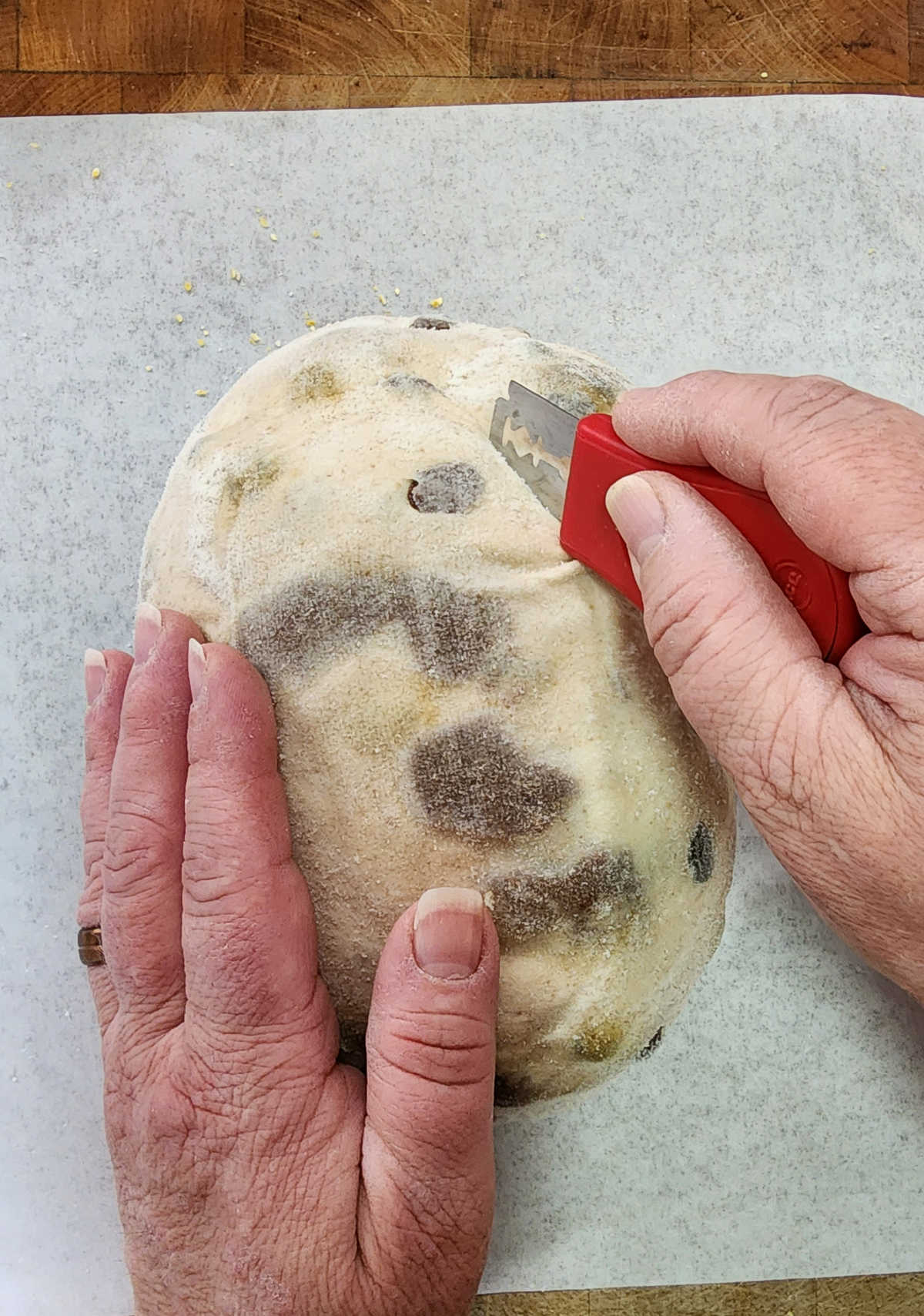

Recipe FAQs
Yes, absolutely. If you’re not a fan of raisins you can leave them out or substitute another dried fruit.
Yes, a long cold ferment, up to 36 hours helps build flavor and is essential with this recipe. It will help give your bread that signature tangy taste, chewy texture, interior crumb and crisp, crackly crust.
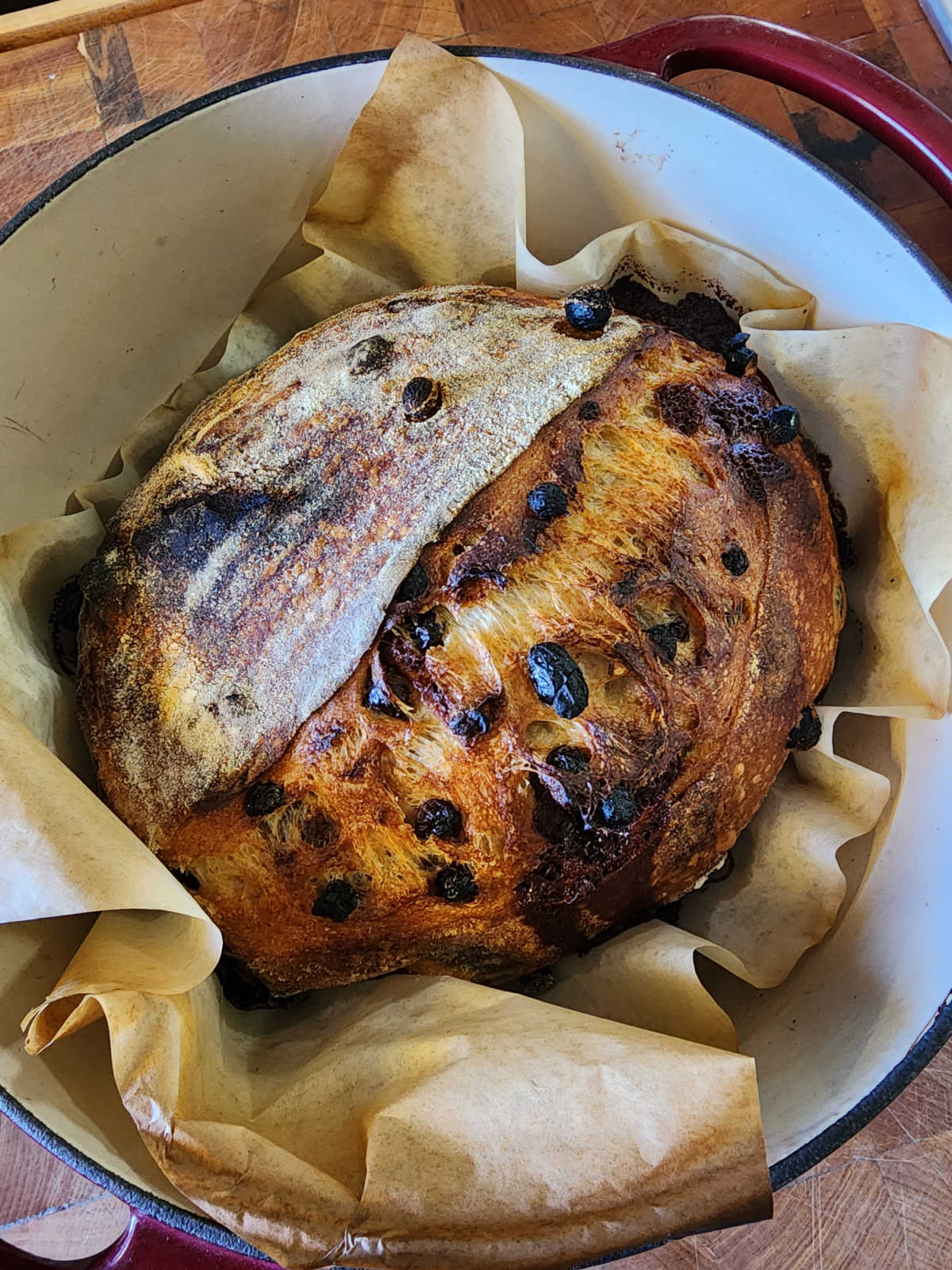

I created a sourdough storefront. These are all the items I use in our kitchen to make sourdough bread. Once you get the hang of making sourdough, you can multiply it and bulk ferment loaves.
Tips on making sourdough
- Use a digital scale to properly measure ingredients. This will give you more consistent results and a must when making sourdough bread.
- Make sure your starter is active. Use the float test to see if it’s ready to make bread. Drop a small spoonful of starter into a small glass measuring cup of water. If it floats to the top, it’s ready to use.
- Potato flakes can give the starter a boost of fermentation, act as a preservative, and add moisture to the bread.
- Bulk dough (meaning multiple batches) proofs faster! Watch it carefully and be careful not to overproof!
- If you have limited refrigeration space, oval bread proofing bowls take up less area.
- Let bread cool for 1-2 hours prior to slicing. Otherwise your bread will be gooey and leak cinnamon sugar mixture.
- Use high-heat kitchen mitts. This is a MUST! The Dutch oven is extremely hot and will burn through most pot holders. It will burn you severely if you are not careful.
More easy bread recipes
Did you make one of my recipes? Please take a moment to leave a star rating. Also, if you are on Pinterest, please feel free to leave a comment there! Follow A Farmgirl’s Kitchen on FACEBOOK, PINTEREST and YouTube and subscribe my mailing list for ALL the latest recipes!
Cinnamon Raisin Sourdough Bread
Ingredients
Cinnamon Raisin Sourdough Bread
- 500 grams unbleached bread flour (mix of unbleached bread flour and whole white wheat flour)
- 100 grams active sourdough starter
- 375 grams lukewarm water (reserve 25 grams for after Fermentolyse)
- 10 grams sea salt
- 110 grams (¾ cup) raisins (added during stretch and folds)
Cinnamon Filling
- ¼ cup (65 grams) packed brown sugar
- ¼ cup (½ stick) butter, softened
- 2-3 teaspoons ground cinnamon
- 2 tablespoons all-purpose flour
Instructions
Levain
- The night before, feed the starter. (4-8 hours prior to making the bread) Place in a warm area (78-80 degrees F) to let it expand. It will build bubbles and double in size. Once it’s at peak or nearly at peak fermentation, place it into the fridge overnight.
- Day of making bread; take the ripe starter out of the refrigerator in order to come to room temperature.
Fermentolyse
- In a large bowl or plastic container, mix the water, active starter and flour. Use a Danish dough whisk to mix as best as you can. This is a lower hydration dough, so you can use your hands to incorporate the ingredients. Mix until the flour is incorporated. The dough will be sticky and shaggy. Cover and let rest in a warm area (78-80 degrees F) for 30 minutes.
Add Salt and Mix
- Mix in the salt and pour over the reserved 25 grams of water.
- Mix by hand, using wet fingers to press the salt into the dough. Mix until ingredients are incorporated. Perform the first set of stretch and folds. Cover with a damp cloth, plastic wrap or reusable shower cap and let rest for 30-minutes.
Bulk Fermentation
- Perform three more stretch and folds, at 30-minute intervals. Add the raisins during the second set of stretch and folds.
- Using slightly wet hands, pinch the dough with your fingers and gently stretch it up, wiggle a little and fold it back down over the dough past the center and release. Turn the bowl or container slightly and repeat this process around the dough. Rotate the bowl about 5 times until the dough starts to take shape. (This process will help strengthen the gluten)
- Coil folds can also help strengthen your dough. Simply lift the dough from both sides and let it fold under itself. Rotate your bowl or container and repeat the process. Let the dough rest 30 minutes in between each coil fold.
- Use a kitchen timer to remember when to perform S&Fs
- Let the dough rest and increase in size. At the end of bulk fermentation, the dough will have risen 30-50%. Anywhere from 2-4 hours (depending on how cold or warm it in your house)
Mix Cinnamon Filling
- In a medium bowl, combine brown sugar, cinnamon and flour with a spoon. Use your fingers or a large spoon to combine with the softened butter. Cover with plastic wrap and set aside.
Shape the Dough
- Once the dough is bubbly and risen 30-50%, shape into rounds. Turn the dough out onto a very lightly floured work surface. Use your hands to gently stretch the dough into a rectangle, roughly 12×10-inches. Be careful not to stretch the dough too thin, as it will create holes.
- Be careful not to add too much flour to the work surface.
- Use your fingers to place the cinnamon filling in small dollops on the dough. Fold it towards the center on each side. Add any remaining cinnamon filling on the long rectangle you’ve created. Roll up into a cylinder shape, using your fingers to create tension as you roll it. With two hands, grab the top of the rectangle. Stretch it away from you and tuck it down over the rest of the dough. Continue to roll, tuck and fold the dough towards the center, until it’s completely sealed. (see the video)
- Alternatively, you can gently spread the cinnamon filling mixture across the rectangle, keeping it about 1-inch or so from the edges.
- Dip your fingers into flour if needed. Use a bench scraper in your right hand, along with your other hand to rotate the dough. (If left handed, do the opposite)
Cold Proof
- Place shaped dough rice floured bannetons, cover with a plastic bag or reusable plastic shower caps, refrigerate overnight. Or up to 36 hours.
Scoring and Baking
- Pre-heat the oven with the Dutch oven for 1 hour. (I use a 10-inch banneton for this recipe!)
- Remove plastic shower cap. Sprinkle top of dough with a pinch of cornmeal. Turn the dough out onto a piece of parchment paper.
- Score the bread RIGHT before baking. Deep score last.
- Carefully lift the parchment paper with dough into the preheated Dutch oven.
- Bake at 500 degrees F in a Dutch oven with the lid on for 20 minutes. Take the lid off and bake at 450 degrees F for 15-20 minutes. To prevent the bottom of the bread from burning, place a half sheet pan underneath the Dutch oven during the last portion of baking.
- Look for the color and internal temperature should be 200-205 degrees F.
- Let cool for at least 1-2 hours before slicing
Video
Recipe Notes
Nutrition
Disclosure: As an Affiliate Marketer, I earn from qualifying purchases. If you click a product affiliate link on A Farmgirl’s Kitchen and make a purchase, I may receive a commission at no additional cost to you! I own every cooking product I recommend and love how they perform.





Megan says
I have been WAITING for this recipe! When I saw you posted it, I immediately fed my starter so I could make it. So good with cream cheese, too!
Jessica Robinson says
Thank you so much!!! We toasted it and had it with cream cheese last week. Was SO delicious!